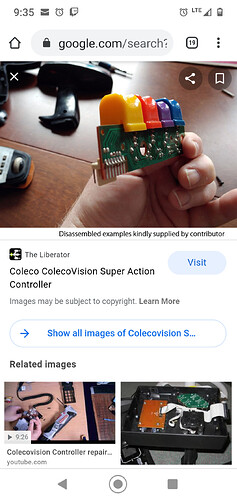The default Super Action stick is good for the type of games Coleco plays.
It’s the buttons that are the big problem. the long button throw makes rapid firing a finger workout.
I know ergonomically it’s a different design than a traditional fight stick. This was the mentality of pre-crash joystick design. You gain ambidexterity and what you lose by it is arm symmetry. One arm has to reach higher or further than the other which causes muscle pains which forces you to switch sides. So home-style ambidexterity wasn’t just a feature, it was a necessity. The other thing you lose is the fact that it’s handheld and it’s so heavy.
I was just seeing how easy it was to remove the long throw of the buttons.
My main coleco joystick will be the stick on my website sinistersticks.com , trying to combine the best of modern joystick design with ambidexterity. Since it is a naked PCB-free joystick initially and you add the PCB with a db37 hookup, I just have to hire my laborer, Stan Escolano, to wire up an Edladdin ColecoVision PCB to my db37 to be used on the Sinister Stick.
By the way there’s one big issue you’re going to have to worry about with ColecoVision that is unique to the ColecoVision, and I did that in anticipation of my Sinister Stick: I don’t know what the correct exact electrical term is but there’s basically two return paths or two grounds. The directions and first action button use ground A, the second through fourth buttons and presumably the keypad to use ground B. I have no idea which ground the speed roller uses for its return.
Luckily, I have one super action controller where the joystick was busted. I was going to have built a cradle to hold a super action joystick so that the keyboard and the speed wheel could be used, and we don’t have to go about bother recreating them, just connect them with a DB9 straight-pin-for-pin y cable. If you can’t figure out a technology, Incorporated intact into a new design.
As for the solution, I use more pins (37?!) and gave each input a separate ground and have the PCB combine them which would normally be into one ground but in the Colecovision PCB will be to the two corresponding grounds based on where it should normally go.
And also I got a microchip-free way of enforcing it when switching controls: binding the appropriate input and its respective ground in a 3.5 mm TRS cable. I could have used a TS system but first, TRS equipment is cheaper than TS. And second, if there’s something I haven’t anticipated I could use the extra signal for something.
If you open the superex controllers you notice there’s a very analog connector like a rod that presses into a button. That’s why natively Colecovision super action controllers are considered high maintenance. Just about as high maintenance as the notorious Atari 5200 controller. But Best Electronics solved that.

